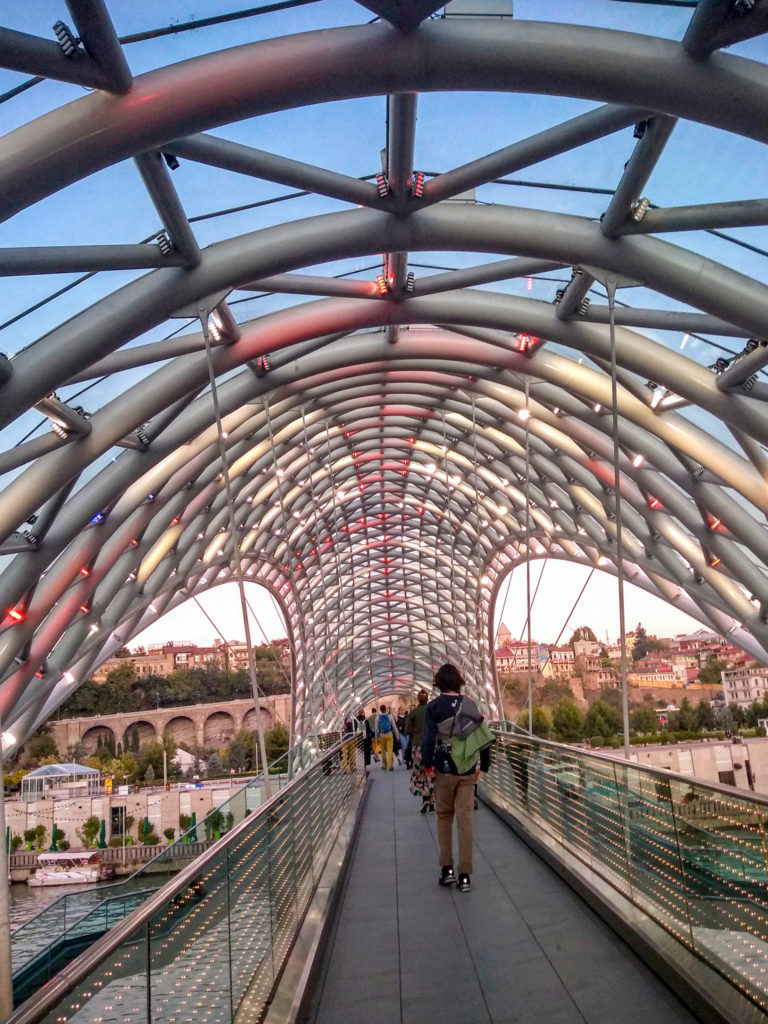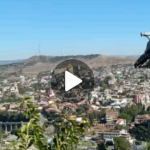“Rome of the Caucasus”.

See photos
Where is Tbilisi?
The city of Tbilisi is the capital and the largest city of Georgia. On the banks of the Mtkvari River in the South Caucasus of Eastern Georgia. The city has the shape of an amphitheatre surrounded by mountains on three sides. To the north by the Saguramo Range. To the east and south-east by the Lori Plain. To the south and west by the Trialeti Range.

Getting there
Our journey from Stepantsminda to Tbilisi was by marshrutka.
Our accommodation
Our time in Tbilisi we chose to stay at the Bright 1BR Apartment, booked through Airbnb.
A bright and spacious apartment in the Old Town district of the city. It has a fully equipped kitchen and comes with a washing machine.
Places of interest
Tbilisi is a vibrant multicultural city. With so many things to visit and see. Most of which are within walking distance from the Old Town. There is an abundant mix of architectural delights. From the ancient Narikala fortress and Holy Trinity Cathedral of Tbilisi to the ultra modern Rike Concert Hall and the Bridge of Peace.
We took advantage of the Tbilisi free walking tour. A 2.5-hour walking tour around the Old Town area of the city. Booking is recommended.

There are two tours a day, leaving from Rustaveli Metro station at 1100 hrs and 1500 hrs. The guide is easy to identify as he has a Red Umbrella. It is recommended to arrive 15 minutes before the tour starts. Our guide was full of information about Tbilisi and the history of Georgia.
In our opinion, it’s a really worthwhile tour and you only pay what you feel the tour was worth. We got to visit the old Soviet cable car station, together with numerous houses that we would never have seen if we hadn’t taken the tour.

During our time in Tbilisi, we visited the following places. Either on the walking tour or on our own:-
The Bridge of Peace
A glass and steel pedestrian bridge that is one of the modern symbols of the city. It is illuminated by an LED display in the evenings. At the eastern end of the bridge is another modern landmark.

Rike Park
Probably the main recreational area of Tbilisi. A place to relax and stroll around in tranquility. It is also home to the Rike Park Concert Hall and Exhibition Centre. An intriguingly shaped set of buildings that resemble two metal tubes next to each other.


Presidential Palace
In a commanding position above the Concert Hall and Exhibition Centre is the impressive looking Presidential Palace. The centre point of which is the three-dimensional bent glass dome.
The Holy Trinity Cathedral
Commonly referred to as Sameba. It is the main cathedral of the Georgian Orthodox Church in Georgia. Regarded as an eyesore by many people, the cathedral is erected on the Elia Hill. Overlooking the Presidential Palace. Consisting of nine chapels, five of which are underground. The cathedral is built in a traditional Georgian style.
Metekhi Church of the Assumption
On the bank of the Mtkvari River, situated on Metekhi Cliff, opposite the Old Town is Metekhi Church of the Assumption. On the boundary of the church stands the statue of King Vakhtang Gorgasali.

Tbilisi Cable Car
Tbilisi cable car connects Rike Park to Narikala Fortress. It costs 2.5 GEL per person one way. Offering fantastic views of the city from the windows. The journey is over all too quickly. When you arrive at the top there are a couple of things to see.

Once there, you can wander around the walled area. Enjoying the awesome views of the whole of Tbilisi, Abanotubani (the sulphur baths district) and the Botanical Gardens.
Tip 🚡
Wait for the car with the sign saying “only 5 people allowed”. It has a glass floor, allowing even better views.
Narikala Fortress
Sitting on top of Sololaki Hill is Narikala Fortress. An ancient fortress overlooking Tbilisi. The fortress consists of two walled sections on the steep hill between the sulphur baths and the Botanical Gardens of Tbilisi. On the lower level is the restored church of St Nicholas.
Kartlis Deda
A couple of minutes walk from the fortress is Kartlis Deda, the Mother of Georgia. A statue of a woman carrying a bowl of wine in one hand and a sword in the other. These represent Georgian hospitality and their fighting spirit.

Botanical Gardens of Tbilisi
These gardens lie in the Tsavkisis-Tskali Gorge on the southern foothills of Sololaki Hill. They can be overlooked from the top of the hill whilst visiting Kartlis Deda and the fortress.
It is a pleasant walk down the hill into the Old Town of Tbilisi.
Abanotubani District
At the bottom of the hill is the Abanotubani District. Home to the sulphur baths of Tbilisi. There are a number of bath houses offering different sulphur bathing experiences. Both private and public. We didn’t choose to use the baths.

Love bridge
Along the path to Leghvtakhevi Waterfall, is Love bridge. A bridge to which people have locked padlocks onto the handrails.

Leghvtakhevi Waterfall
A short walk along the footpath from Love Bridge is Leghvtakhevi Waterfall. Which it is hard to believe is in the centre of the old town area of the city.

Tamada
Walking back through the old town there is a sculpture of a man holding a horn, Tamada. A Georgian toastmaster an important position and highly regarded.

Liberty Square
It’s a 10 min walk from Tamada to Liberty Square. A grand statue of St George sited in the middle of the square.

Rustaveli Avenue
Liberty Square leads onto Rustaveli Avenue. A tree lined Avenue which has numerous shops, the Opera House, Parliament building, and the National Museum located on it.
Getting around
There is a comprehensive public transport system serving Tbilisi. A Metromoney Card (a travel card) is required to travel on the metro, buses, marshrutkas along with the cable car. The card is purchased for 2 GEL. The metro and buses use a flat-fare system of 50 Tetri per journey.
Credit for journeys can be added at any metro station or at one of the many payment points located throughout the city. One card can be used for multiple passengers.
The 2 GEL paid for the Metromoney Card is refundable when the card is finished with. The original purchase receipt must be presented at the time of returning the card. So keep the receipt.
Metro
The metro system is an efficient system. Soviet style stations, very deep underground and vividly decorated. The system consists of 2 lines. They stretch across the city and are usefully sited for getting to the main tourist attractions. Trains come every 3-5 minutes and can often be full. The system operates from 0700 hrs until 0000 hrs. Only a Metromoney Card is accepted for entry into the system.
Buses
The bus system of Tbilisi is easy to use. The buses are synced with Google maps. Making journey planning easy. They are blue or yellow, each displaying its route number on the front. Most bus stops have an automated information board. Pay when boarding (putting the correct amount of coins in the machine) or touch the machine with the Metromoney card.
Marshrutkas
All the marshrutkas in the city are yellow. Use the Tbilisi Minibus website to find out the number of the marshrutka for the route you want to take. Then simply flag it down as it approaches. On Rustaveli Avenue they will only stop if you are at a bus stop. A journey costs 80 Tetri.
New minibuses can be paid for with the Metromoney card. Payment can also be made in cash to the driver.
There are also 2 Marshrutka Stations for national travel and an international bus station.
Didube Marshrutka Terminal serves north and west Georgia. Samgori Marshrutka Terminal serves east Georgia. Ortachala Central Bus Station serves international routes to Turkey, Azerbaijan, and Armenia.
Tip
Do not confuse the Didube marshrutka terminal with the Didube Bus Terminal. They are not the same and are in different locations. The marshrutka terminal is adjacent to the Didube Metro station. The Bus Terminal is adjacent to Didube Train Station. They are 500m apart.

